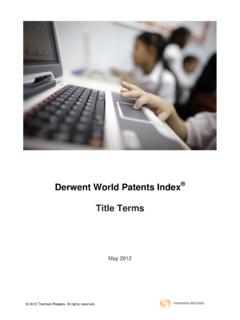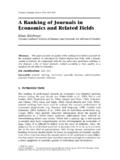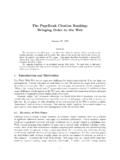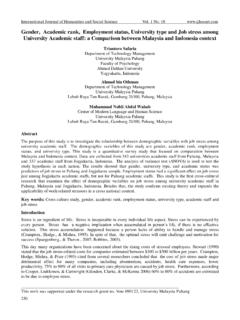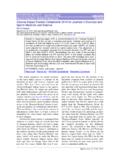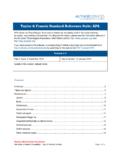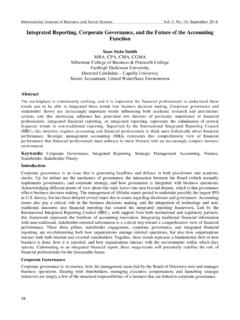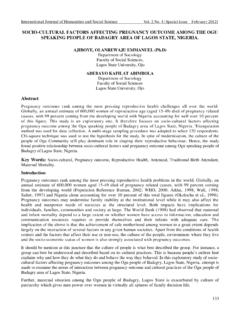Transcription of Open Access Journals in the Thomson ISI citation Databases ...
1 Open Access Journals in the ISI citation Databases : Analysis of Impact Factors and citation Patterns A citation study from Thomson Scientific Marie E. McVeigh October 2004. Abstract: The value and viability of Open Access (OA) Journals remain prominent topics of debate in the library and publishing communities for many months now. In the time since Thomson Scientific (a Thomson business) first studied the citation impact of Open Access (OA) Journals using the 2002 journal citation Reports (JCR ), discussion of the value and viability of this Access model has continued. When the 2003 JCR was published in June 2004, we took the opportunity to re-examine the coverage and citation performance of OA Journals in the ISI citation Databases in the context of the emerging issues in the open Access debate. We have also broadened the study to consider not only OA Journals , but the potential influence of other types of OA publishing on the availability of materials covered by Thomson products.
2 An increasing number of Journals covered in the ISI citation Databases are adopting an OA distribution model. In addition, we continue to evaluate and select new OA. Journals . Although the largest number of OA Journals is in Medicine and Life Sciences, OA Journals in Physics, Engineering & Mathematics are more frequently among the highest ranking Journals in their categories. It is still the case that more of the currently available OA Journals rank in the lower half of their subject category, despite the presence of some OA Journals in the top ranks. Within the collection of OA titles, however, there is a notable tendency to rank higher by Immediacy Index than by Impact Factor, irrespective of the subject. Open Access Journals are not necessarily new publications. In fact, Open Access at the journal level comprises a complex picture of availability.
3 Many established Journals make only a few recent years of content available online, while the majority of their content is accessible only through traditional Access paths. Other established Journals , having moved to OA distribution, offer Access to many years of older content as well. The evolving environment of scholarly publishing includes additional avenues for making content openly available. Our findings suggest that over 55% of the Journals and over 65% of the articles indexed in Web of Science in 2003 are produced by publishers who permit some form of self-archiving, and could be made OA by author archiving. Coverage of Open Access Journals : The mission of Thomson Scientific is to maintain a database of world-wide scholarly content that helps researchers find the highest quality literature relevant to their work. To fulfill this mission, our staff of editors evaluates over two thousand new and established Journals each year to assess their value to the database as a Only about 10% of these Journals are selected for coverage.
4 Journals in all disciplines in science, social sciences, and arts and humanities that meet and maintain high standards in their publication practices and editorial content are selected for coverage, and are indexed in Thomson products. citation data are also considered in the review of a title as it presents an independent demonstration by the scholars in the subject that the content of a journal is relevant and valuable to their work. The evaluation process is independent of the journal 's business or Access model. Copyright 2004 Thomson Corporation Based on the 2002 JCR, in April of this year, we published an initial study of the OA Journals that appear in Thomson ISI products and found that 192 OA Journals are indexed for our products. The Journals were distributed across many subjects, and showed a wide range of values for their journal Impact Factor a key performance metric for the ranking and comparison of Journals .
5 2 The principle finding of the study was that an OA distribution model did not appreciably alter the performance of a journal , either positively or negatively. At that time, the majority of the OA Journals covered were ranked in the lower half of Journals in their subject when ranked by Impact Factor. However, there were some very notable exceptions; in each of the broad subject areas studied there was at least one OA title that ranked at or near the top of its field. For this study, we used the same on-line resources as in the previous work to create a list of available OA Journals : the DOAJ ( ), J-STAGE ( ) and SciELO. ( ).3 At the time of our analysis, these three sites listed a total of 1190 unique titles. Of these, 239 (nearly 20%), are currently indexed in our ISI citation Databases . These 239 titles represent approximately of the nearly 9000 Journals in the Web of Science and approximately 1% of the 20,000 Journals in ISI Web of KnowledgeSM.
6 An additional eight titles are listed in one or more of the online OA directories, and appear in previous years' content of Web of Science, but are not currently indexed either because the title of the serial was changed (where the new title will be counted as current coverage), ceased publication, or was removed from coverage. Appendix A contains a list of the OA Journals indexed for the ISI citation Databases . Open Access coverage increased by 43 titles between February and June of 2004. However, only six OA titles were selected for coverage de novo in 2004. The remaining 37 Journals either recently shifted to an OA distribution model, or were recently recognized as OA by one of the resources analyzed. It was not possible to distinguish between these mechanisms in our analysis. Figure 1 compares the number of OA Journals covered in each of six major subject areas: Chemistry; Physics, Engineering & Mathematics; Medicine; Life Sciences; Social Sciences.
7 And Arts & Humanities. Copyright 2004 Thomson Corporation 2. Distribution of OA Journals by subject 80. February 2004 - 192 titles 70 June 2004 - 239 titles 60. Number of Journals 50. 40. 30. 20. 10. 0. Chemistry Physics, Life Sciences Medicine Social Arts &. Engineering Sciences Humanities &. Mathematics Figure 1: Change in coverage of OA Journals from February 2004 to June 2004. Five of six subject areas show an increase in the number of OA Journals . Chemistry is the exception, showing no increase in the number of OA Journals . The largest increase was in Physics, Engineering & Mathematics, with an increase of 16 titles. Medicine showed a net increase of 14 titles. In contrast, Social Sciences, and Arts & Humanities with few OA titles, added only four and two titles, respectively. Open Access Journals by Region We analyzed the OA Journals by region, taking the publisher's country as the point of origin of each journal (see Figure 2).
8 Distribution of OA Journals by Region Western Europe, 45. Asia Pacific, 79. South/Central America, 33. Eastern Europe, 19. North America, 58. Middle East/Africa, 5. Figure 2: Distribution of OA Journals by region. Copyright 2004 Thomson Corporation 3. Just over one-third of OA Journals in this study are published in Asia-Pacific, while North America and Western Europe (including the United Kingdom) together account for approximately 40% of OA titles. This distribution differs strongly from the ISI citation Databases as a whole, where North America and Western European publishers provide nearly 90% of the journal titles, although Journals from over 70 countries are covered. We considered the number of OA Journals from a region relative to the total coverage of Journals from that region in the ISI citation Databases (see Table 1). This reveals a striking result.
9 Nearly 15% of the covered titles from Asia-Pacific are available as OA, and over 40% of the titles from Central or South America are OA Journals . In contrast, OA Journals from North American and Western Europe comprise and , respectively, of the total coverage from those regions. For many Journals , providing free content online expands their Access to an international readership. Number Number of of Region OA Journals Journals % OA. Asia-Pacific 79 530 Eastern Europe 19 282 Middle East/Africa 5 57 North America 58 3910 South/Central America 33 78 Western Europe 45 3961 Whole database 239 8818 Table 1: Proportion of OA Journals from each region compared to all Journals covered in the ISI citation Databases . Open Access Journals : Rank by Impact Factor and by Immediacy Index Immediacy Index and JCR Impact Factor are considered to be critical journal performance metrics, as they reflect the citation activity for journal articles one to three years after their initial publication.
10 An Immediacy Index considers only one year of data and can be calculated after a journal has been indexed and cited for one full year. Because it considers citations to articles in the same year as their publication, the Immediacy Index is an indication of the speed with which items published in the journal are incorporated into other literature's references. A high Immediacy Index suggests that the journal 's content is quickly noticed, highly valued and topical within its field4. Immediacy Index considers only same-year citations, and does not always capture even the most rapid acknowledgement of articles published late in the year. Impact Factor calculation requires three years of data, since it considers citations to articles two or three years after their publication5. This is a period of rapidly increasing citation activity for articles in all subjects.
